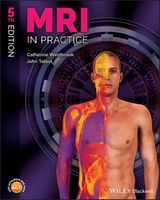MRI in Practice
Wiley-Blackwell (Verlag)
978-1-119-39196-8 (ISBN)
This latest edition offers in-depth chapters covering all core areas, including: basic principles; image weighting and contrast; spin echo pulse sequences; gradient echo pulse sequences; spatial encoding; k-space; protocol optimization; artefacts; instrumentation; and MRI safety.
- The leading MRI reference book and study guide
- Now with a greater focus on the physics behind MRI
- Offers, for the first time, equations and their explanations and scan tips
- Brand new chapters on MRI equipment, vascular imaging and safety
- Presented in full color, with additional illustrations and high-quality MRI images to aid understanding
- Includes refined, updated and expanded content throughout, along with more learning tips and practical applications than previous editions
- Features a new glossary.
»MRI in Practice« is an important text for radiographers, technologists, radiology residents, radiologists, and other students and professionals working within imaging, including medical physicists and nurses.
Catherine Westbrook, Senior Lecturer and Course Leader, Magnetic Resonance Imaging (MRI), Faculty of Medical Science, Anglia Ruskin University, Cambridge, UK.
John Talbot, Senior Lecturer in Magnetic Resonance Imaging (MRI), Research Methodology and Medical Education, Faculty of Medical Science, Anglia Ruskin University, Cambridge, UK.
Preface to the Fifth Edition
Acknowledgments
List of Acronyms
Equation symbols
About the Companion Website
Chapter 1 Basic principles
Introduction
Atomic structure
Motion in the atom
MR active nuclei
The hydrogen nucleus
Alignment
Net magnetic vector (NMV)
Precession and precessional (Larmor) frequency
Precessional phase
Resonance
MR signal
Pulse timing parameters
Further reading
Chapter 2 Image weighting and contrast
Introduction
Image contrast
Relaxation
T1 recovery
T2 decay
Contrast mechanisms
Relaxation in different tissues
T1 contrast
T2 contrast
Proton density contrast
Weighting
Other contrast mechanisms
Further reading
Chapter 3 Spin echo pulse sequences
Introduction
RF rephasing
Conventional spin echo
Fast or turbo spin echo FSE/TSE)
Inversion recovery (IR)
Short tau inversion recovery (STIR)
Fluid attenuated inversion recovery (FLAIR)
Further Reading
Chapter 4 Gradient echo pulse sequences
Introduction
Variable flip angle
Gradient rephasing
Weighting in gradient echo pulse sequences
Weighting mechanism 1 extrinsic contrast parameters
Weighting mechanism 2 the steady state
Weighing mechanism 3 residual transverse magnetization
Coherent or rewound gradient echo
Incoherent or spoiled gradient echo
Reverse-echo gradient echo
Balanced gradient echo
Fast gradient echo
Echo planar imaging (EPI)
Further reading
Chapter 5 Spatial encoding
Introduction
Mechanism of gradients
Gradient axes
Slice selection
Frequency encoding
Phase encoding
Sampling
Data collection and image formation
Bringing it all together pulse sequence timing
Further reading
Chapter 6 k-space
Introduction
Part 1 what is k-space?
Part 2 - how are data acquired and how are images created from this data?
Part 3 some important facts about k-space
Part 4: how do pulse sequences fill k-space?
Part 5: options that fill k-space
Further reading
Chapter 7 Protocol optimization
Introduction
Signal to noise ratio (SNR)
Contrast to noise ratio (CNR)
Spatial resolution
Scan time
Trade-offs
Protocol development and modification
Further reading
Chapter 8 Artefacts
Introduction
Phase mismapping
Aliasing
Chemical shift artefact
Out of phase signal cancellation
Magnetic susceptibility artefact
Truncation artefact
Cross-excitation/cross-talk
Zipper artefact
Shading artefact
Moire artefact
Magic angle
Equipment faults
Flow artefacts
Flow-dependent (non-contrast enhanced) angiography
Black-blood imaging
Phase contrast MRA
Further reading
Chapter 9 Instrumentation
Introduction
Magnetism
Scanner configurations
Magnet system
Magnet shielding
Shim system
Gradient system
RF system
Patient transport system
Computer system and graphic user interface
Further reading
Chapter 10 MRI safety
Introduction (and disclaimer)
Definitions used in MRI safety
Psychological effects
The spatially-varying static field
Electromagnetic (radiofrequency) fields
Time-Varying Gradient Magnetic Fields
Cryogen safety
Cryogen safety
Additional resources
Further reading
Appendix
Glossary
Index
| Erscheinungsdatum | 04.10.2018 |
|---|---|
| Verlagsort | Hoboken |
| Sprache | englisch |
| Maße | 203 x 254 mm |
| Gewicht | 904 g |
| Einbandart | kartoniert |
| Themenwelt | Medizinische Fachgebiete ► Radiologie / Bildgebende Verfahren ► Kernspintomographie (MRT) |
| Schlagworte | Kernspinresonanz, MRT, MRI • Kernspintomographie • MRI |
| ISBN-10 | 1-119-39196-2 / 1119391962 |
| ISBN-13 | 978-1-119-39196-8 / 9781119391968 |
| Zustand | Neuware |
| Informationen gemäß Produktsicherheitsverordnung (GPSR) | |
| Haben Sie eine Frage zum Produkt? |
aus dem Bereich




